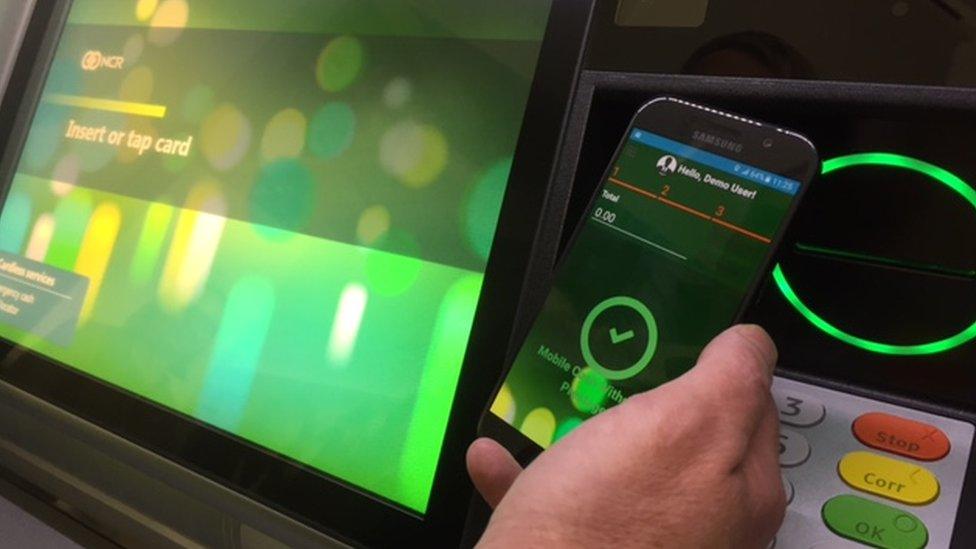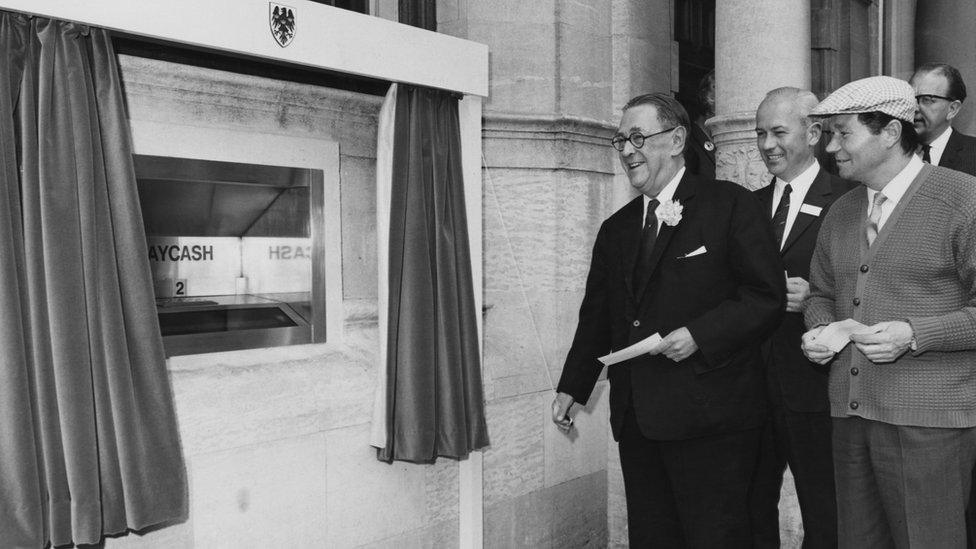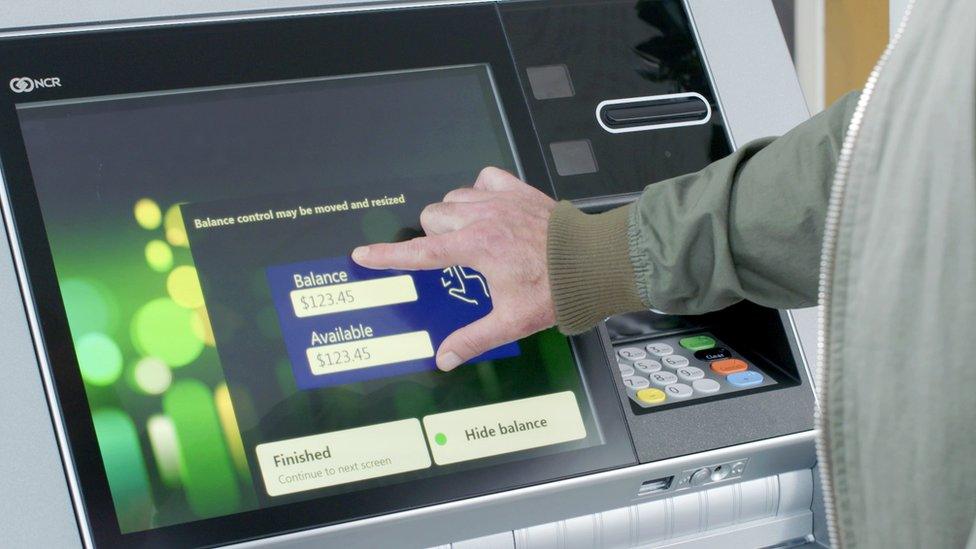Future of cash: Can a 'bank in a box' replace a branch?
- Published

NCR's latest model of ATM can wirelessly connect with your smartphone
Watch a queue of shoppers for a minute and they will be preparing to pay in very different ways.
Some will pull out a debit or credit card ready to put in a reader. Others might use their smartphone to complete their purchase, the rest will be paying in cash.
The group using notes and coins is still significant but their numbers are starting to dwindle, particularly among the young.
That spells trouble for the operators of cash machines. Time then for a reinvention of the humble ATM [automated teller machine] but in a digital world what can you do with a hole in the wall whose primary function is dispensing cash?
The answer is a "bank in a box", a machine that is the alternative to a branch serving all your financial needs with 24/7 opening hours, says one manufacturer.
Other experts are more sceptical. They say all that can be done is to manage the decline of ATMs, and cash in general, until they are replaced entirely by a digital wallet found on our phones.
Early days
This debate is a far cry from the hurried signing of contracts, over a pink gin, between Barclays and John Shepherd-Barron in the UK some 50 years ago.
The deal, between bank and inventor, led to the first ever cash machine being installed in London in 1967.
All did not go entirely to plan. When one was installed in Zurich, Switzerland, there was a mysterious malfunction. Eventually, it was found that wires from two intersecting nearby tramlines were interfering with the mechanism.

Barclays Bank unveiled its first cash machine in the UK in 1967
Yet with other devices also being patented, the ATM soon evolved and its use spread widely.
The latest figures show that ATM numbers in the BRIC nations [Brazil, Russia, India, China] have gone up sharply and machines remain a constant if not growing sight in Western Europe.
Russia, has seen rapid growth in recent years, according to a report by Payments UK, while growth in India is coming, in part, from the development of solar-powered ATMs in rural areas.
Portugal has the highest proportion of cash machines in Western Europe with 1,516 machines per one million residents.
Sweden, typical of a Scandinavian shift towards a cashless society, has the lowest with 333 machines per one million inhabitants.

Solar-powered ATMs are useful in rural locations and at festivals
Tellingly the popularity of ATMs in Portugal may not necessarily have anything to do with cash.
"Cash machines in Portugal are part of a fully integrated cross-bank network," says Payments UK's Cash and Cash Machines report.
"This has allowed a number of innovations offering a range of other bank-related functions and services, such as cash and cheque deposits and also other services such as cinema and concert ticket purchases, tax payments, bill payments, and mobile phone top-ups."
Reinvention
So what new technology is coming along to replace the button-operated ATMs?
One of the major international ATM manufacturers and software suppliers, NCR, has just started marketing its latest "self-service" machine.
It claims users will never look at an ATM in the same way again - mainly owing to the fact that they think they are looking at a tablet computer.

Functions allow the customer to swipe, pinch and zoom on the colourful 19-inch screen, just like on a tablet. And there is a video banking option to allow people to talk to bank staff.
Instead of fighting against the advance of smartphones, it also allows people to complete withdrawals or transactions that they started on their phone.
It has already been installed in drive-throughs in the US, and Rachel Nash, area director of NCR, says that it will soon be seen across the UK, Europe, then Australia and New Zealand and onwards.
"It bridges the gap between the mobile-first customer and those who want nothing to do with it [digital banking]," she says.

ATM use around the world

The first newly-designed ATM by NCR has just been installed in Switzerland
As of 2014, Russia had the highest number of cash machines per one million inhabitants than any European country
In Western Europe, Portugal had 1,516 ATMs per one million people in 2014. The UK had 1,074, while the average in the EU was 960
The UK recorded 54 cash machine withdrawals per person in 2014 - the highest in the world
Germany and Belgium have the largest amount of cash withdrawn per adult in Western Europe. Adults in these countries on average withdraw over £3,500 a year from cash machines
India has the lowest value of cash machine withdrawals with less than £270 per adult a year. However, this value has slowly increased over the past few years
Source: Payments UK

NCR says its research shows that 80% of the transactions typically completed inside a physical branch can be completed through a video teller at an ATM.
"This is perfect to leave behind when a branch closes," says Ms Nash. "It is a bank in a box."
This is one of many new ATM designs on the market. But some argue that the ATM will never beat the smartphone as the hardware of choice when managing our financial affairs in the future.
Greg McBride, chief financial analyst at Bankrate.com, says: "ATMs will continue to evolve in terms of functionality, with increased use of the phone to access cash via the ATM.
"While the long-term viability of ATMs might be threatened by a move to a cashless society, it is too soon to put them on the endangered species list."
He points out that if and when ATM usage declines in the US, fees are likely to rise for customers who use machines not in their bank's network.

Will we soon be able to do all our banking without talking to anyone in person?
But Robert Wardrop, co-founder of the Cambridge Centre for Alternative Finance based at the Cambridge Judge Business School, believes that as smartphone digital wallets become more convenient, so cash machine use will decline.
Given that such technology has been in place for some time, only privacy concerns and regulation have stopped that happening sooner.
Some people still value the anonymity of cash, he says.
"[Digitally] all your transactions are transparent, so those worried about a Big Brother world will push back against that."
So consumer preferences will ultimately determine the future of cash machines and, indeed, cash itself.
The power lies with those shoppers standing in line, and how they decide to pay.
Follow Technology of Business editor Matthew Wall on Twitter, external and Facebook, external